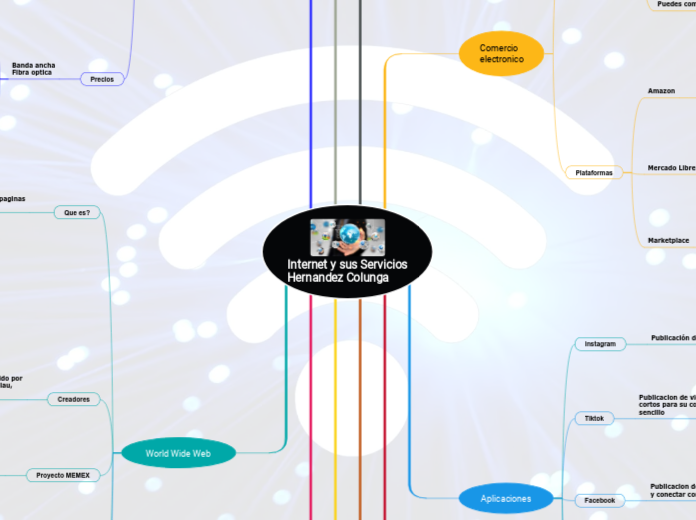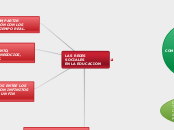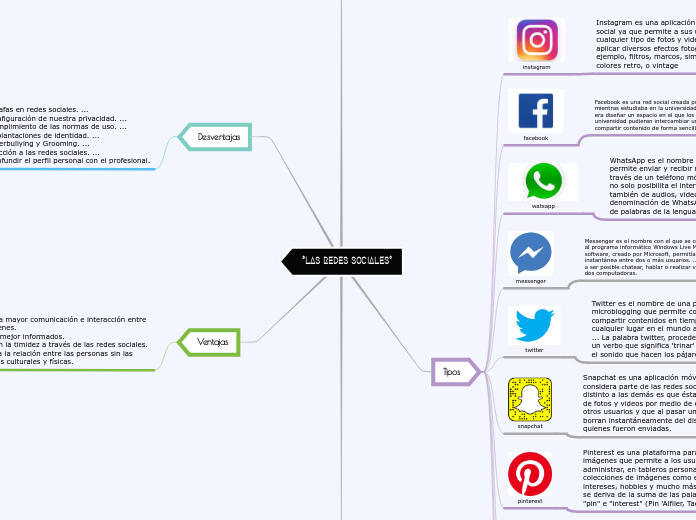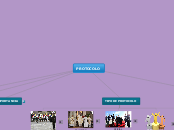Bibliografia:
Que es Internet. (2023). Retrieved February 15, 2023, from Ucr.ac.cr website: https://ccp.ucr.ac.cr/cursoweb/112que.hm
Copia de Infografía de Proceso Periódico Vintage Antiguo Marrón. (2023). Canva. https://www.canva.com/design/DAFaDR47UFA/MOIlsIbJzxWdFcHPNYjMtg/edit
Forero, T. (2019, August 17). Historia del Internet: una línea del tiempo de la red. Rock Content - ES. https://rockcontent.com/es/blog/historia-del-internet/
Tipos de conexión. (2023). Enacom.gob.ar. https://www.enacom.gob.ar/tipos-de-conexion_p112
¿cómo funciona una red móvil? - Las ondas. (2023). Las Ondas. https://radio-waves.orange.com/es/como-funciona-una-red-movil/
WhistleOut MX. (2020, April 30). Servicios de internet en México | izzi, Totalplay, Megacable y más. WhistleOut; WhistleOut. https://www.whistleout.com.mx/CellPhones/Guides/servicios-de-internet
HTTP - Concepto, para qué sirve y cómo funciona. (2013). Concepto. https://concepto.de/http/
¿Qué son los DNS y cómo funcionan? - Webempresa. (2020, September 22). Webempresa. https://www.webempresa.com/hosting/que-son-dns.html
Internet y sus Servicios
Hernandez Colunga
The Solar System is the gravitationally bound system of the Sun and the objects that orbit it, either directly or indirectly. Of the objects that orbit the Sun directly, the largest are the eight planets, with the remainder being smaller objects, the dwarf planets, and small Solar System bodies.
Breve historia
Surgio en 1969
Creado por el
Departamento
de
Defensa de los
Estados Uinido
Se presento
publicamente
en 3 años
Conectando tres
universidades de
California y una
de Utah
Con el objetivo de
Crear una una linea de
comunicacíon en caso
de una guerra nuclear
Que se envia
A traves del
Protocolo IP
Protocolo que asina
una identificación unica
a cualquier dispositivo
conectado
Consisten en
Una Red descentralizada
(existen varios nodos)
Servidores o "nodos"
que proveen informaicon
Interconetadas
A nivel mundial
Es una red compuesta de
Computadoras
Conceptos
Saturn is known most for its rings.
Galileo Galilei first thought it was an object with three parts: a planet and two large moons on either side.
Not knowing he was seeing a planet with rings, the stumped astronomer entered a small drawing — a symbol with one large circle and two smaller ones — in his notebook.
The rings are made of ice and rock and scientists are not yet sure how they formed. The gaseous planet is mostly hydrogen and helium.
URL
La URL es una forma de organizar
información en la web, es como una
dirreción que permite acceder a un
archivo o pagina web
DNS
Es un sistema de nomenclaturas que
se encarga de traducir nombres
ilegibles a un formato legible (IP)
How long does it take for Saturn to go around the sun?
HTTP
Es el protocolo que se utiliza
para enviar y recibir información
en la web
A planet's day is the time it takes the planet to rotate or spin once on its axis.
Write down Saturn's day measured in Earth days.
HTML
Es el lenguaje de programción
predominante a la hora de
diseñar una pagina WEB
World Wide Web
Uranus is an oddball. It has clouds made of hydrogen sulfide, the same chemical that makes rotten eggs smell so foul.
It rotates from east to west like Venus. Its tilt causes extreme seasons that last 20-plus years, and the sun beats down on one pole or the other for 84 Earth-years at a time.
Methane in the atmosphere gives Uranus its blue-green tint. It also has 13 sets of faint rings.
Tim Berners-Lee
Establecio la primera conexion de entre
un cliente y un servidor usando el Protocolo
HTTP en 1989
Xanadú
Se buscacaba crear un tipo de hipertexto
en cual se podria saltar de uno a otro a
traves de Hipervinculos, ademas generaria
ganancias a los autores de documentos
citados
Uranus has 27 moons that we know of. Five of the moons are large and the rest are much smaller.
Name these 5 moons.
Fue diseñado por Ted Nelson
Proyecto MEMEX
Seria un dispositivo de busqueda
de una base datos que almacenaria
todo tipos de datos
How long does it take for Uranus to go around the sun?
Fue diseñado por
Vannevar Bush
Creadores
Fue creado por un equipo dirijido por
Tim Berners-Lee y Robert Cailliau,
en Suiza, en el año de 1955
A planet's day is the time it takes the planet to rotate or spin once on its axis.
Write down Uranus's day measured in Earth days.
Que es?
Es un sistema interconectado de paginas
publicas a través de internet
Servicios de
internet
Neptune is about the size of Uranus and is known for supersonic strong winds.
Neptune is far out and cold.
The planet is more than 30 times as far from the sun as Earth.
Neptune was the first planet predicted to exist by using math, before it was visually detected. Neptune is about 17 times as massive as Earth and has a rocky core.
Precios
Banda ancha
Fibra optica
Neptune has thirteen moons that we know of and one more waiting for confirmation.
The largest moon is slightly smaller than Earth's Moon and has active volcanoes which erupt like geysers and eject nitrogen frost over the surface.
Name this moon and at least 4 others.
Mega Cable
50 Mbps
$520
IZZI
50 Mbps
$450 al mes
Total play
40 Mbps
$529 al mes
Redes Moviles
Se basa en el principio general de la
telefonia, conectar 2 usuarios a traves
del equipo de un operador
How long does it take for Neptune to go around the sun?
Para que funcione correctamente los
usuarios deben estar al alcance de una
antena, que manda la información a la
central y esta envia la informacion a
otra antena que la envia al usario 2
Fibra Optica
Utiliza un cable formado por dos capas
de silicio en lugar de cobre, gracias a
esto alcanza una mayor velocidad
A planet's day is the time it takes the planet to rotate or spin once on its axis.
Write down Neptune's day measured in Earth days.
Un emisor manda un haz de luz que rebota
de un extremo a otro del cable, es resivido
por un MODEM, que reconstruye la información
Banda Ancha
Utiliza el mismo cable telefonico
Pero utiliza bandas de frecuencias
diferentes para transmitir la voz y el
internet de manera simultanea
La linea del
tiempo
It was once considered a planet but in August 2006 the International Astronomical Union (IAU) downgraded the status of Pluto to that of “dwarf planet.”
Pluto is unlike other planets in many respects. It is smaller than Earth's moon; its orbit is highly elliptical.
It's a cold, rocky world with a tenuous atmosphere. Pluto is a very active ice world that's covered in glaciers, mountains of ice water, icy dunes, and possibly even cryovolcanoes that erupt icy lava made of water, methane or ammonia.
1972
Se crea el correo
electronico
The dwarf planet Pluto has five moons.
Name these moons.
ARPANET se encuentra consolidada
con cientos de computadoras cinectadas
Ray Tomlinson crea el sofware
basico del correo electronico
y se convierte en la aplicación
mas importante
Gracias a esto ARPANET se alejaba de
su uso militar y convirtiendose, en
un metodod de divulgación
En 1966
Se Creo ARPANET
A planet's day is the time it takes the planet to rotate or spin once on its axis.
Write down Pluto's day measured in Earth days.
Gracias a Robert Kahn y
Howard Frank
Lograron una conexión por nodos
exitosa, logrando conectar
una computadora de la
Universidad de California (UCLA)
Y otra en el Instituto de
Investigación de Stanford (SRI).
Esta conexion fue tan exitosa
que en pocos meses despues
se unieron 4 universidades
En 1965 se crea
La primera red amplia
(WAN)
How long does it take for Pluto to go around the sun?
Gracias a
Conectaron una computadora
TX2 y una Q-32 usando una
linea teefonica
Thomas Merrill
en California
Lawrence G. Roberts
en Massachussets
Comienza en 1958
Cuando ARPA
(Advanced Researchs
Projects Agency)
Comienza a desarrollar
neuvas tecnologias,
debido a la Guerra Fria
Redes
Sociales
Jupiter is a giant gas world that is the most massive planet in our solar system.
Its swirling clouds are colorful due to different types of trace gases.
And a major feature in its swirling clouds is the Great Red Spot, a giant storm more than 10,000 miles wide. It has raged at more than 400 mph for the last 150 years, at least.
Jupiter has a strong magnetic field, and with 75 moons, it looks a bit like a miniature solar system.
Tendencias
Las tendencias son temas que se vuelven
super relevantes gracias a la exposición
que generan las redes
Jupiter has a strong magnetic field, and with 75 moons, it looks a bit like a miniature solar system.
Name the 4 most known moons.
Beneficios
Mayor visivilidad para el emprendimiento
Permite encontrar a personas
con los mismos gustos
Facilita la comunicación
Conexión con personas de otros paises
Streaming
Mars is a cold, desert-like place covered in dust. This dust is made of iron oxides, giving the planet its iconic red hue.
Mars shares similarities with Earth: It is rocky, has mountains, valleys and canyons, and storm systems ranging from localized tornado-like dust devils to planet-engulfing dust storms.
Este termino tiene
2 asepciones
Plataforma de Streaming: Es una plataforma
que ofrece un gran cataologo de series y/o
peliculas a un bajo costo
Stream: Personas que realizan una
actividad en la computadora(usualmente
jugando), minetras lo transmiten en vivo
a través de alguna plataforma
How long does it take for Mars to go around the sun?
Aplicaciones
Earth is a water world, with two-thirds of the planet covered by oceans.
It's the only world known to harbor life.
Earth's atmosphere is rich in nitrogen and oxygen.
Its name originates from 'Die Erde,' the German word for 'the ground.'
Earth may once have had two moons, nowadays it has just one.
Classroom
Herramienta auxiliar para la
realizacion de clases
Yotube
Publicacion de videos mas
extensos y generar ganancias
How long does it take for Earth to go around the sun?
Publicacion de contenido
y conectar con mas personas
A planet's day is the time it takes the planet to rotate or spin once on its axis.
Write down the Earth's day in hours.
How many hours
Tiktok
Publicacion de videos
cortos para su consumo
sencillo
Instagram
Publicación de fotos
Comercio
electronico
Venus is Earth's twin in size and has no moons.
Its surface has various mountains and volcanoes. Because of its thick, toxic atmosphere that's made of sulfuric acid clouds, Venus is an extreme example of the greenhouse effect. The average temperature on Venus' surface is 900 F (465 C).
Venus spins slowly from east to west, the opposite direction to most of the other planets.
The Greeks believed Venus was two different objects — one in the morning sky and another in the evening. Because it is often brighter than any other object in the sky, Venus has generated many UFO reports.
Plataformas
Marketplace
Mercado Libre
Amazon
A planet's day is the time it takes the planet to rotate or spin once on its axis.
Write down Venus's day measured in Earth days.
Caracteristicas
Puedes comprar 24/7, 365 dias al año
Utilizan una interfaz amigable
y llamativa para poder captar
tu atención
Usualmente solo se permite
el pago por metodos digitales
Our Solar System has eight “official” planets which orbit the Sun.
Each planet is at a different distance from the sun. Name its position.
Paginas
Mercury is the smallest, only a little bit larger than Earth's moon. Mercury has no moon.
It experiences dramatic changes in its day and night temperatures: Day temperatures can reach a scorching 840 F (450 C), which is hot enough to melt lead. Meanwhile, on the night side, temperatures drop to minus 290 F (minus 180 C).
It also has a very thin atmosphere of oxygen, sodium, hydrogen, helium, and potassium and can't break-up incoming meteors, so its surface is pockmarked with craters, just like the moon.
Facebook
Es una red social donde puedes encontrar
personas que ya conoces y otras que, ademas
puedes subir videos, fotos y textos, ademas
de poder comentarlas
Additional info
Steam
Es una plataforma donde se comercializan
juegos de grandes compañias y juegos hechos
por estudios y/o personas independientes
How long does it take for Mercury to go around the sun?
How many days
Gmail
Es un plataforma que permite
enviar y recibir correos electronicos
A planet's day is the time it takes the planet to rotate or spin once on its axis.
Write down Mercury's day measured in Earth days.
How many Earth days
Youtube
Es una plataforma que permite
que cualquier persona suba videos
bajo ciertas condiciones y permite
genarar dinero por la publicidad
Position
Spotify
Es un servicio de streaming
de musica que permite a
cualquiera reproducir y subir
contenido
a









